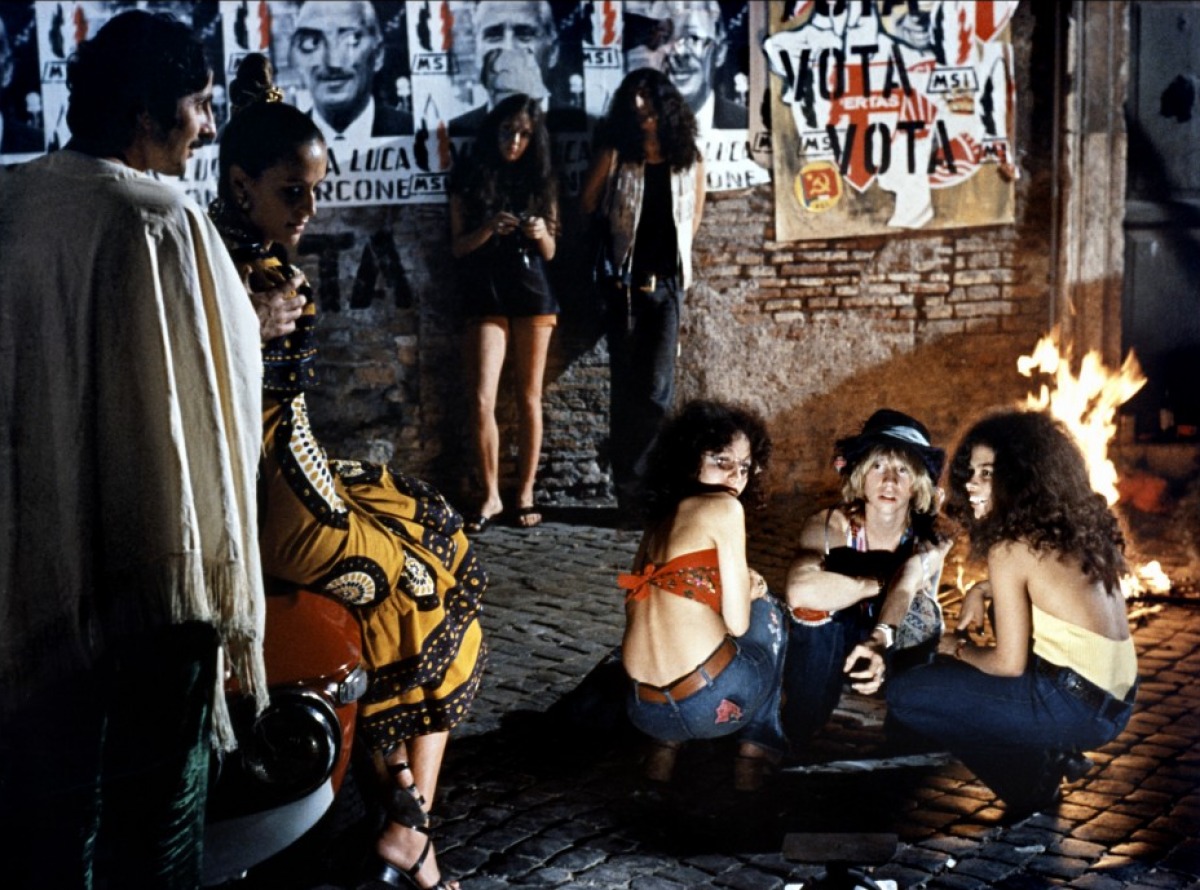Digging the Eternal City
The screen seems to catch only a thin slice of Federico Fellini’s cinematic feasts, as though his copious caricatures, surrealistic landscapes and theatrical extravaganzas could fill the sky if only some way were found to protect them against the heavens. He is the last of the great epic filmmakers, bound to other contemporary directors in his obsession with personal themes but able to dramatize these private materials—memories, dreams, fantasies—on a monumental scale. In 8½ he made a monstrous carnival of his daily life. Satyricon transfigured the stuff of his id into a mythic drama. Even his childhood romance with buffoons and harlequins became, in Clowns, the beginning of an epic quest after a vanished kingdom of comedy.
Now, he has transformed Rome into a giant metropolis of the imagination. Fashioned more from memories and feelings than brick and mortar, it is Rome as the young Fellini, fresh from the provinces, apprehended it thirty years ago, as the maturing Fellini explored and imbibed it until its monuments took root in his soul, and as Fellini finds it today, fearing for its fate under the onslaught of modern life. Fellini’s Roma is a thrilling personal memoir, imperfect and sprawling only because it breaks so much new ground—its cavalcade of images, ideas and forms all harnessed to a strangely exhilarating vision of impending doom.
Fellini discards the twin staples of character development and continuous narrative in favor of a series of set pieces organized around the tension between Rome’s mythic past and uncertain future. Retaining the wide-eyed curiosity he brought to Rome as a youth from Rimini, Fellini takes us back to the boarding house that was his first Roman home. Like the city itself, the rooming house was an extended family that spilled out into the working-class streets, filled with grotesques whose histories were written plainly in the eccentric lines of their faces.
Fellini takes us to a street feast, a human comedy of performing kids, jealous husbands, complaining wives and dyspeptic diners. He shows us the old bordellos that were the social safety valve of a repressed society—the working-class cathouses in which hookers of all shapes, sizes and come-ons strutted their hot stuff before crowds of ravenous males, and the upper-class fleshpots with their spacious rococo lobbies, gilded-cage elevators and ambassadorial facades.
Finally, in one of the great set pieces of modern cinema, Fellini re-creates a festive evening at the Jovinelli, the proletarian vaudeville palace where Mussolini and the privations of World War II took second billing to a war between caterwauling amateurs and a crowd that bellowed like a lusty beast, hard to propitiate, easy to enrage, hurling a dead cat at a stumpy, third-rate imitator of Fred Astaire, driving a desperate comic from the stage, swooning ecstatically to the serenade of a girl dressed like a funeral wreath and swaying to the bouncy ballads of three middle-aged matrons coming on like a gargoyle parody of the Andrews Sisters.
Against this gaudy backdrop of a Rome recollected in tranquillity, Fellini vaults us into the present with a grueling trip along a hectic autostrada, a cortege of cacophony and catastrophe culminating in a traffic jam of hallucinatory proportions at the foot of the Colosseum. Beneath the ground, helmeted, faceless workers dwell in the urban inferno of tomorrow, excavating and destroying the beauty of Rome past as they dig a subway, wandering in the ruins like goggled creatures from another dimension.
Everywhere the social pillars of Rome are collapsing. The Catholic Church has become nothing more than an “ecclesiastical fashion show,” complete with nuns parading a “classical new black line for novices” and monks on roller skates showing off the latest in clerical sportswear. A procession of empty cardinals’ robes in gilt and neon climaxes with the frightening figure of an ossified Pope, more wax than man, set high in a meretricious sky of lights, as irrelevant a figure as the sad, foolish aristocratic lady who has mounted this cavalcade of fashions.
Finally, all social cohesion vanishes at a banquet in Trastevere, an ancient section of Rome. Nationless hippies flee from the battering sticks of police as the expatriated Gore Vidal holds forth on the decline and fall of Western civilization and the celebrants slump into a mirthless stupor. Then, suddenly, out of this rubble comes the roar of the new Visigoths. Waves of ominous, helmeted cyclists lift us up and carry us about the city’s great monuments, roaring toward that abiding symbol of the past, the Colosseum. It is doomsday in the form of a breathless joy ride. In a stroke of genius, Fellini has resolved the tensions of past and future by turning these heralds of a feared tomorrow into the escorts of our final dazzling tour of Rome, their headlong, thunderous anonymity an ironic comment on the eternity of the Eternal City.
Newsweek, October 30, 1972






1 thought on “Fellini’s Roma | Review by Paul D. Zimmerman”
Can you please post up Stanley Kauffmann’s review of “The Piano”? Thanks.